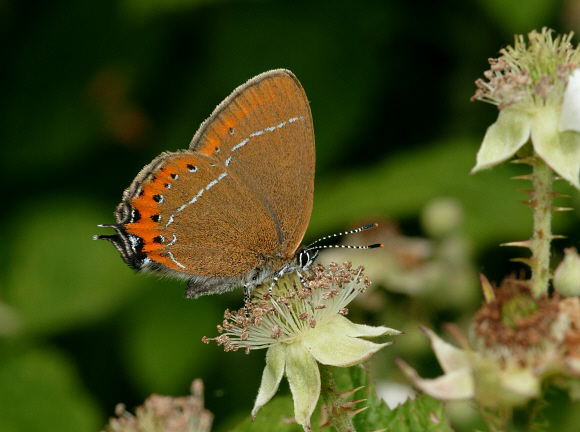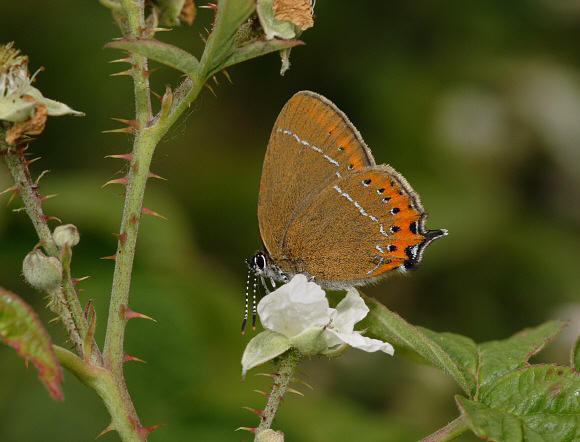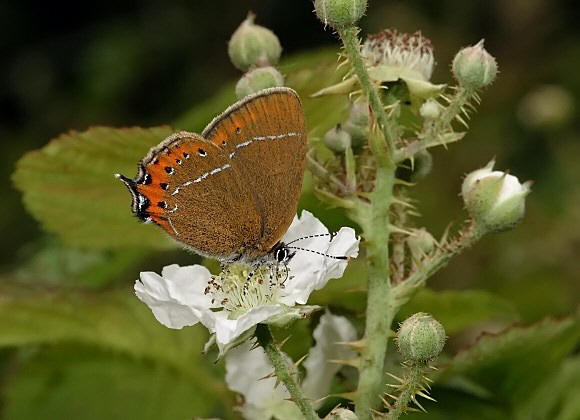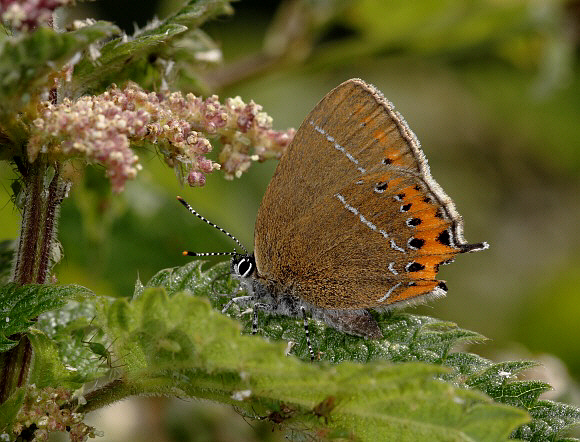 Black Hairstreak Satyrium pruni, female nectaring at bramble, Northants – Adrian Hoskins
Black Hairstreak Satyrium pruni, female nectaring at bramble, Northants – Adrian Hoskins
Introduction
The Black Hairstreak is widespread across central and eastern Europe, but is absent from the Iberian peninsula, the Mediterranean coast, northern France, and most of Finland and Sweden. Throughout Europe it is considered to be a scarce and very localised species, although it’s habitat requirements do not appear to be particularly specialised.
Beyond Europe it’s range extends eastward through southern Siberia, Mongolia and Korea to Japan.
It is possible to confuse this species with the White-letter Hairstreak Satyrium w-album, which lacks the black spots on the underside, and in which the white median line forms a distinctive “W” shape. In continental Europe it can also be confused with the Blue-spot Hairstreak S. spini, the underside hindwing of which bears a perfectly straight white line, and a blue spot on the tornus.
 Black Hairstreak Satyrium pruni, antennae-dipping to “taste” nectar-source – Adrian Hoskins
Black Hairstreak Satyrium pruni, antennae-dipping to “taste” nectar-source – Adrian Hoskins
Habitats
In Britain this species is a rarity, now confined to about 30 small woodland sites within a narrow strip of land running diagonally from Oxford to Peterborough.
At these sites the butterfly nearly always occurs as tiny populations, breeding on tall blackthorn bushes Prunus spinosa growing in sheltered and sunny situations. These are typically on the southern edge of a woodland, or in small glades, or along ride edges, but colonies also exist in hedgerows or in scrubby meadows close to woodland.
Blackthorn hedges that are trimmed are entirely unsuitable for this species. Almost all of the sites where it survives in Britain are specifically managed for the Black Hairstreak, by ensuring the retention of well established blackthorn hedgerows, and fencing them when necessary to prevent the bushes being grazed by cattle or deer.
Although the butterflies usually oviposit on long established bushes, good conservation also requires that new young bushes are encouraged, to ensure an uneven age structure of blackthorn. Bramble and privet bushes also appear to be significant elements in this species ecology, as they provide vital nectar sources for the adults.
 Black Hairstreak Satyrium pruni, female at bramble – Adrian Hoskins
Black Hairstreak Satyrium pruni, female at bramble – Adrian Hoskins
Lifecycle
The butterflies are single-brooded, emerging in mid-June. The flight period is of very short duration, no more than 2-3 weeks, and individual butterflies appear to only live for about a week.
The brown disc-shaped eggs are laid singly on blackthorn twigs, usually on the sunlit side of the bush, at any height, and often close to forks in the twigs. They are laid in June or very early July.
The caterpillars are fully formed within the eggs by late July, but do not hatch until the following March when the flower buds appear.
When very young the caterpillars are dark brown, and rest on the unopened leaf buds. They feed at first on the flower buds, moving onto the leaf buds in April and May. As they develop they undergo several changes in colour and pattern. When fully grown in late May they are green, with pale diagonal stripes on each segment, and prominent pink-tipped ridges along the back. They feed diurnally, and rest fully exposed on the upper surface of the leaves.
In late May the pupa, which is black marked with white patches, and perfectly disguised as a small bird dropping, is formed attached by a silk girdle to a twig, or less commonly on the top of a blackthorn leaf.
 Black Hairstreak Satyrium pruni, female at bramble – Adrian Hoskins
Black Hairstreak Satyrium pruni, female at bramble – Adrian Hoskins
Adult behaviour
The adults emerge in the early morning, and shortly afterwards can sometimes be found settled on blackthorn twigs waiting for the wings to harden. Freshly emerged butterflies are brightly coloured and very beautiful, but within a day or two they become faded and worn, the red submarginal band quickly fading to pale orange, and the rich golden brown ground colour fading to greyish brown.
Males tend to sit motionless for very long periods at the top of blackthorn bushes to intercept passing females. I have not observed any form of pre-nuptial ritual, and it is likely that the butterflies copulate almost immediately after meeting. Copulation usually occurs in late morning, at the top of blackthorn bushes, but the butterflies will often fly short distances when copulated – I have for example seen photographs of copulated pairs nectaring at bramble.
In hot and sunny conditions females walk about on blackthorn twigs, usually near the top of tall bushes, laying their eggs singly on or close to forks in the twigs. After laying several eggs they take a period of rest, and this is followed by a period of nectaring. The females descend regularly to nectar at privet, bramble, dogwood, wayfaring tree and field rose, but are very secretive and easy to overlook. They tend to descend more frequently in warm muggy overcast conditions than in full sunshine, and often spend several minutes sitting on a particular bramble or privet flower. They also imbibe “honey-dew” -a sugary secretion produced by aphids which coats the upper surface of leaves, particularly blackthorn and ash.
 Satyrium pruni, female imbibing aphid secretion from the surface of nettle leaves – Adrian Hoskins
Satyrium pruni, female imbibing aphid secretion from the surface of nettle leaves – Adrian Hoskins
In late afternoon, when the changing position of the sun causes the bushes which they occupy to become shaded, they migrate across glades to seek the last remaining sunlit areas. They roost overnight on the upper surface of blackthorn leaves, amidst the tangle of growth within the bush.
